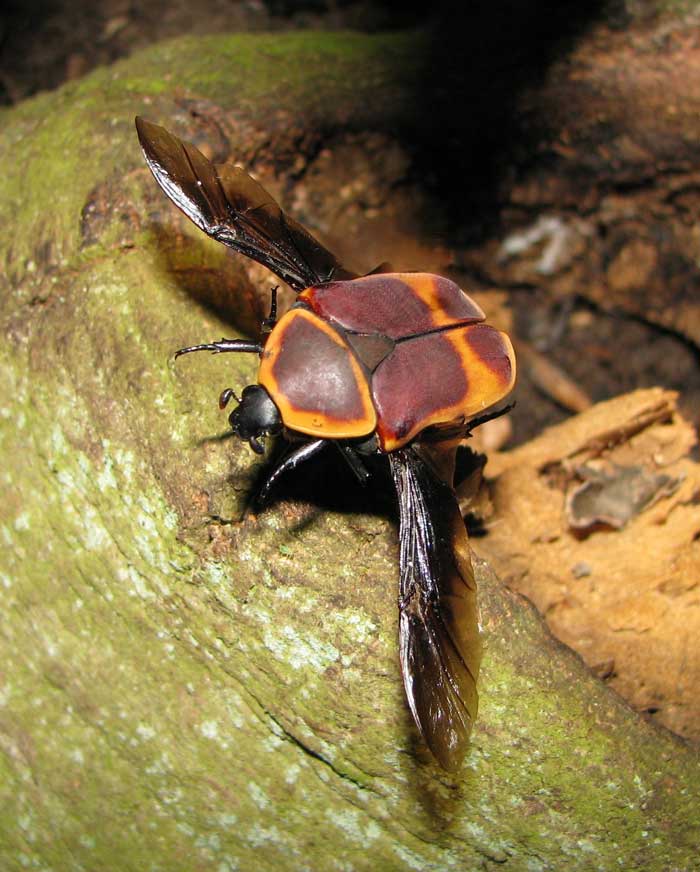
Pachnoda marginata peregrina (*)
Superregnum: Eukaryota
Cladus: Unikonta
Cladus: Opisthokonta
Cladus: Holozoa
Regnum: Animalia
Subregnum: Eumetazoa
Cladus: Bilateria
Cladus: Nephrozoa
Cladus: Protostomia
Cladus: Ecdysozoa
Cladus: Panarthropoda
Phylum: Arthropoda
Subphylum: Hexapoda
Classis: Insecta
Cladus: Dicondylia
Subclassis: Pterygota
Cladus: Metapterygota
Infraclassis: Neoptera
Cladus: Eumetabola
Cladus: Endopterygota
Superordo: Coleopterida
Ordo: Coleoptera
Subordo: Polyphaga
Infraordo: Scarabaeiformia
Superfamilia: Scarabaeoidea
Familia: Scarabaeidae
Subfamilia: Cetoniinae
Tribus: Cetoniini
Subtribus: Cetoniina
Genus: Pachnoda
Species: Pachnoda marginata
Subspecies: P. m. aurantia – P. m. cerandi – P. m. fernandezi – P. m. mirei – P. m. murielei – P. m. peregrina – P. m. tunisiensis
Name
Pachnoda marginata (Drury, 1773)
References
Arndt Löwenberg: Exotische Käfer, Pflege und Zucht von Rosen- und Riesenkäfern im Terrarium. bede, Ruhmannsfelden 1999. ISBN 3-933646-44-8
Vernacular names
Deutsch: Kongo-Rosenkäfer
English: Taxicab Beetle
magyar: Kongói rózsabogár
Pachnoda marginata is a beetle from the subfamily Cetoniinae with a large number of subspecies that lives in west and central Africa. They are sometimes used as food for terrarium animals. The adult beetles are 20–30 mm, the larvae are very small when they hatch, but can grow as long as 60 mm. (2.36 in.) It is commonly called the sun beetle.
Description
The sun beetle comes in nine subspecies, the three common ones are: Pachnoda marginata aurantia, Pachnoda marginata marginata, Pachnoda marginata peregrina, with ranging colors. Pachnoda marginata aurantia comes from orange to a yellow-orange, some having a hue gradient towards the middle seen in diagram below. Pachnoda marginata marginata normally is red or crimson with little change between individuals. Pachnoda marginata peregrina, the more common amongst the subspecies, is a pale yellow or orange with brown spots; one spot being on the thorax and two spots on each elytra on each wing.
Sometimes the spots on the elytra are almost unnoticeable, as they seem to blend in with the rest of the body, this can be seen in the picture on the bottom left of Pachnoda marginata peregrina in the terrarium under "As pets".
The larvae of the pachnoda can sometimes make a low snore-like noise when making their cocoons.
List of the described subspecies
Pachnoda marginata aurantia (Herbst, 1790)
Pachnoda marginata cerandi Rigout, 1984
Pachnoda marginata fernandezi Rigout, 1984
Pachnoda marginata marginata (Drury, 1773)
Pachnoda marginata mirei Ruter, 1963
Pachnoda marginata murielae Rigout, 1987
Pachnoda marginata perigrina Kolbe, 1906
Pachnoda marginata rougeoti Rigout, 1992
Pachnoda marginata tunisiensis Rigout, 1984
Life cycle
After mating, the female lays an egg in moist ground, which hatches after a short time into a larva that feeds voraciously for 2 to 5 months. When the larva has matured, it pupates for several weeks, and then transforms into an adult beetle. It will live as an adult for several months. Not all larvae survive pupation, many die before molting into pupa form.
As pets
Pachnoda marginata is an easy beetle to keep, requiring a terrarium with a lid (as it can fly out), a layer of moist ground, something to climb on, a warming lamp and food like bananas, apples and other fruits. The larva also eat leaves and other plant waste. It is important to not mix coniferous material in the substrate for these beetles as it may harm the larvae.
References
1. Rigout (J.), 1989, The Beetles of the World, volume 9, Sciences Nat, Venette. [1]
2. Rigout (J.), 1992, The Beetles of the World, volume 12, Sciences Nat, Venette. [2]
Retrieved from "http://en.wikipedia.org/"
All text is available under the terms of the GNU Free Documentation License

